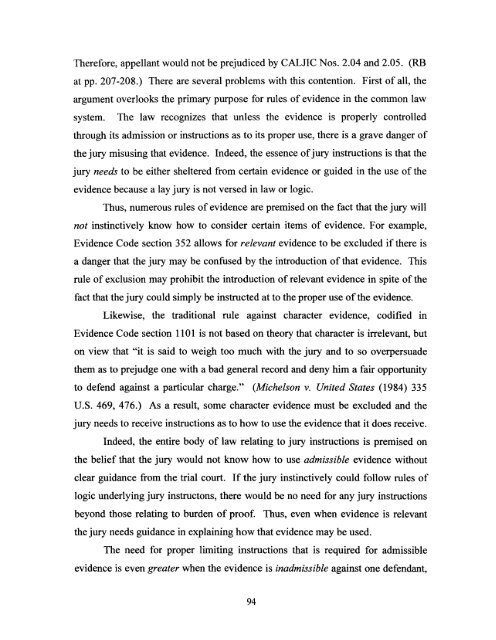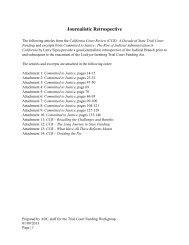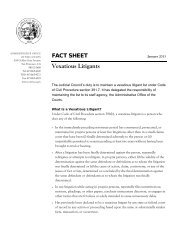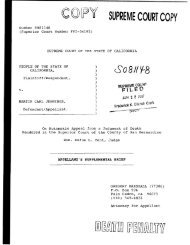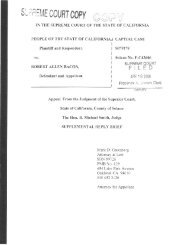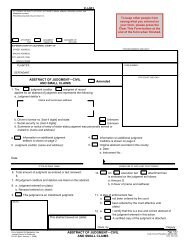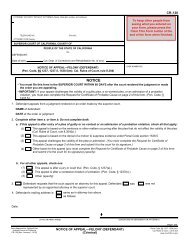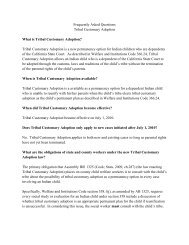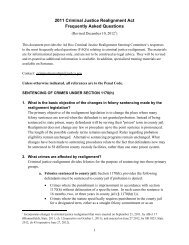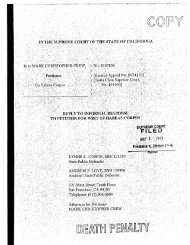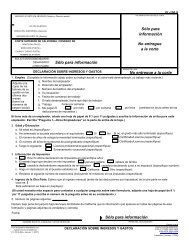Appellant, William Satele, Reply Brief - California Courts - State of ...
Appellant, William Satele, Reply Brief - California Courts - State of ...
Appellant, William Satele, Reply Brief - California Courts - State of ...
You also want an ePaper? Increase the reach of your titles
YUMPU automatically turns print PDFs into web optimized ePapers that Google loves.
Therefore, appellant would not be prejudiced by CALJIC Nos. 2.04 and 2.05. (RB<br />
at pp. 207-208.) There are several problems with this contention. First <strong>of</strong> all, the<br />
argument overlooks the primary purpose for rules <strong>of</strong> evidence in the common law<br />
system. The law recognizes that unless the evidence is properly controlled<br />
through its admission or instructions as to its proper use, there is a grave danger <strong>of</strong><br />
the jury misusing that evidence. Indeed, the essence <strong>of</strong>jury instructions is that the<br />
jury needs to be either sheltered from certain evidence or guided in the use <strong>of</strong> the<br />
evidence because a lay jury is not versed in law or logic.<br />
Thus, numerous rules <strong>of</strong>evidence are premised on the fact that the jury will<br />
not instinctively know how to consider certain items <strong>of</strong> evidence. For example,<br />
Evidence Code section 352 allows for relevant evidence to be excluded ifthere is<br />
a danger that the jury may be confused by the introduction <strong>of</strong>that evidence. This<br />
rule <strong>of</strong> exclusion may prohibit the introduction <strong>of</strong>relevant evidence in spite <strong>of</strong>the<br />
fact that the jury could simply be instructed at to the proper use <strong>of</strong>the evidence.<br />
Likewise, the traditional rule against character evidence, codified m<br />
Evidence Code section 1101 is not based on theory that character is irrelevant, but<br />
on view that "it is said to weigh too much with the jury and to so overpersuade<br />
them as to prejudge one with a bad general record and deny him a fair opportunity<br />
to defend against a particular charge." (Michelson v. United <strong>State</strong>s (1984) 335<br />
U.S. 469, 476.) As a result, some character evidence must be excluded and the<br />
jury needs to receive instructions as to how to use the evidence that it does receive.<br />
Indeed, the entire body <strong>of</strong> law relating to jury instructions is premised on<br />
the belief that the jury would not know how to use admissible evidence without<br />
clear guidance from the trial court. If the jury instinctively could follow rules <strong>of</strong><br />
logic underlying jury instructons, there would be no need for any jury instructions<br />
beyond those relating to burden <strong>of</strong> pro<strong>of</strong>. Thus, even when evidence is relevant<br />
the jury needs guidance in explaining how that evidence may be used.<br />
The need for proper limiting instructions that is required for admissible<br />
evidence is even greater when the evidence is inadmissible against one defendant,<br />
94


